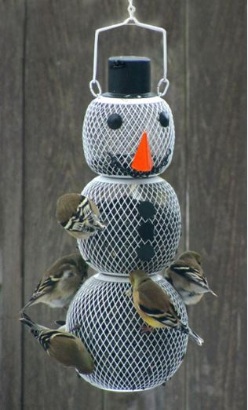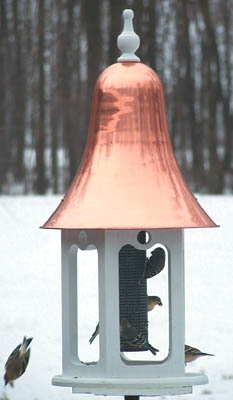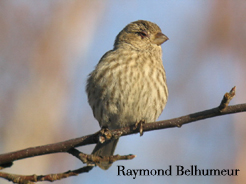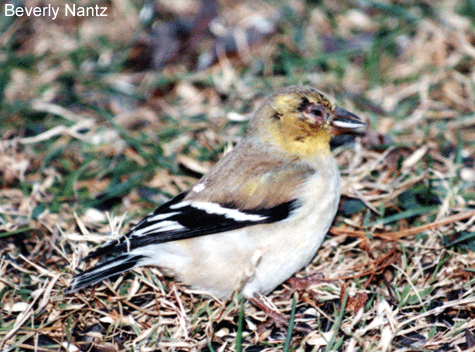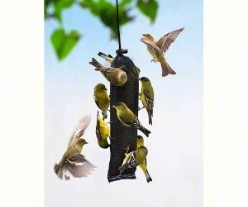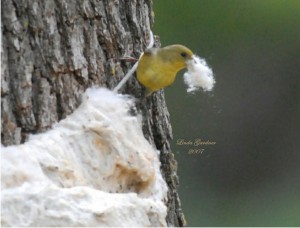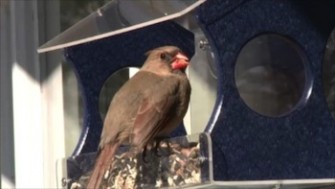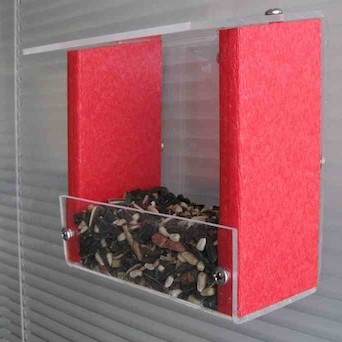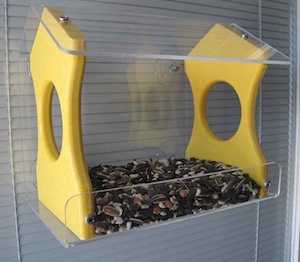-
Watch Out for this at Wild Bird Feeders
Seeing more traffic at your feeders lately? The recent cold snap and first freeze of the season has finches flocking to feeders. The frost will damage some plants with fruit or berries, and likely zap most flying insects. As the cold wears on, these natural food sources disappear so wild bird feeders start seeing increased activity.
Aside from the usual suspects like cardinals, chickadees titmice and wrens, goldfinches are still around from summer- but with their new winter feathers they’re looking a bit drab as seen on
this snowman feeder. House Finches, who tend to travel in large flocks are crowding feeders now too, and they appear at new feeding areas in large groups. These birds are prone to a respiratory infection (see Cornell Lab for the history) that may infect other birds through bird feeders. The disease is actually conjunctivitis, though it’s not transferred to humans.
Affecting their eyes, the bacteria itself is not fatal, but infected birds usually end up blind and die from starvation or predation. You’ll see them with swollen, half-closed, or crusty eyes, and sometimes completely swollen shut. They go where it’s easy to feed, on the ground scavenging below feeders or staying in a nearby tree. It’s really a sad sight, but knowing that other birds may become infected through your feeders is worse.
This is why maintaining clean feeders is important. Non-porous surfaces like glass, copper, recycled plastic or vinyl are much easier to clean than wood. These wild bird feeders promote a healthier environment because bacteria can’t settle into cracks and crevices. There are a few easy steps to help prevent the spread of conjunctivitis and what to do should you see an infected bird in your yard.
- Space feeders as widely as possible to divert large crowds from gathering at one spot.
- Clean feeders with a 10% bleach solution (1 part bleach to 9 parts water) with extra attention to feeder ports. Rinse thoroughly and air dry.
- Rake fallen seed and bird droppings beneath feeders, keeping this area clean.
- Take feeders down if you see one or two birds with infected eyes, and clean as suggested above.
- Some folks even wait to hang feeders again, encouraging the flock to move on.
-
Thistle Feeders are in High Gear Once Again!
It may be officially summer, but the tail end of spring nesting season is still going strong. Goldfinches are just starting to nest now, which means you’ll be seeing a whole lot of yellow at thistle feeders in the next 2-3 months.
If you’re not offering thistle yet, you may be missing out! The American Goldfinch is a favored backyard songbird as their summer plumage, friendly disposition and sweet song are simply a pleasure to have around the garden. And unlike other birdseed, thistle seed won’t germinate… which is also a pleasure in the garden 🙂
Goldfinches don’t use birdhouses, so there’s no luring them in with that. They’ll raise their broods in mature hedges or trees, constructing nests of woven plant fibers and down. You can encourage them with some nesting materials placed in the vicinity of thistle feeders. They’re partial to Hummer Helper, the hummingbird nesting material, feathers and other fibrous nest offerings.
Unlike some more aggressive birds, goldfinches are quite demure, they’d rather fly off than fight for a spot at the feeder. This where lots of perches, or an all-over feeding space to accommodate them are ideal. Thistle socks are another great choice for goldfinches’ busy time of year. You can easily offer several different feeding spots, without spending a whole lot! Parents will feed babies thistle seed almost exclusively at first, sometimes mixed with finely chopped sunflower bits, you’ll see finches consuming this seed mix too.
As always, fresh water is critical to any bird’s environment. Keeping your bird bath clean is important stuff, for them and for your yard – especially in warm summer weather. Keep water shallow (no more than two inches) and keep it fresh… and they will come!
Oh wait, once goldfinches molt again in September they’ll turn an olive-drab color… but don’t quit feeding them. If you offer thistle year-round, their electric yellow plumage will grace your yard every summer!
-
New Recycled Window Bird Feeders Rock!
See birds up close and personal For Earth Day, we chose to feature new and green together. Not quite green in color, the vibrant primary hues make them that much more fun. So what’s so great about our new window bird feeders that’s worth mentioning?
They help keep plastics out of landfills. Back in the day, when our very first poly-lumber (an industry term for recycled plastic) feeders arrived, they had stickers on the roof saying 33 milk jugs were used to make that item. I think the sticker’s still on one of the walls somewhere? Although one feeder may not have much of an impact, when thousands are purchased by consumers… it most certainly makes a difference.
You can attract wild birds in the smallest of spaces with window feeders. The huge yard and landscaping isn’t required. On the balcony or deck, birds will visit your feeders. A shallow pan of fresh water is a good idea, and only helps further entice them.
Recycled plastic (glass and ceramic too) are actually healthier for birds! The non-porous surface thwarts bacteria and mold from settling into crevices. Don’t get us wrong… wood is good, but the slick, smooth surface is much easier to clean and maintain as it resists bacteria that’s harmful to birds.
Will never rot, split, fade, peel, crack or warp! Poly-lumber items are guaranteed by most manufacturers. Color won’t fade as it’s solid all the way through, no top-coatings to chip away over time. The material is so durable, products are guaranteed to never peel, warp, fade, rot, split or crack – pretty impressive really!
Offer birds a variety of treats throughout the year and see who visits? The open dish design of these feeders will not limit you to offering birdseed. Suet and crumbles, shelled peanuts, fruit, jelly placed in a small cup (for orioles, cat birds and woodpeckers), and even mealworms will entice a wide variety of visitors. Offer specialty items in summer for migratory birds, and your basic seed and suet in winter for resident friends.
With spring in the air, we spotted a pair of Indigo Buntings yesterday, and Mr. & Mrs. Red-Breasted Grosbeak today!
So there’s a few good reasons why we think these window feeders are fab, plus they’re bird-tested and bird-approved. To welcome spring and help out Mother Earth, consider a new birdhouse or feeder for your feathered friends… the rewards are well worth the endless hours of entertainment they’ll provide.
Happy Earth Day and thanks for feeding the birds!

